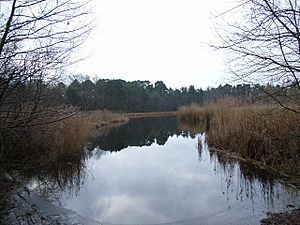Englemere Pond facts for kids
| Site of Special Scientific Interest | |
 |
|
| Area of Search | Berkshire |
|---|---|
| Interest | Biological |
| Area | 26.1 hectares (64 acres) |
| Notification | 1983 |
| Location map | Magic Map |
Englemere Pond is a really special natural area in Berkshire, England. It covers about 26 hectares, which is roughly the size of 64 football fields! This amazing place is officially known as a Site of Special Scientific Interest (SSSI). This means it's protected because it has rare plants, animals, or geological features. It's also a Local Nature Reserve, which means the local council helps look after it for everyone to enjoy. The land belongs to the Crown Estate, and Bracknell Forest Borough Council helps manage it.
Contents
Exploring Englemere Pond's Location
Englemere Pond is located near North Ascot. You can find it between Martins Heron railway station and Ascot railway station. This nature reserve features a shallow lake with slightly acidic water. It also has marshy areas, which are wet lands with lots of grasses and reeds. These different habitats make it a perfect home for many types of wildlife.
A Glimpse into Englemere Pond's Past
For a very long time, Englemere Pond was part of a huge Royal Hunting Forest. This forest surrounded Windsor Castle, a famous home of the British royal family. In 1990, Bracknell Forest Borough Council officially made the site a Local Nature Reserve. This helped protect the area even more. In August 2016, something unexpected happened. An old military shell was found in the pond. Experts safely removed and exploded it in a controlled way.
Amazing Animals at Englemere Pond
Englemere Pond is buzzing with different kinds of animals! From tiny insects to graceful birds, there's a lot to discover here.
Birds Flying High and Low
Many beautiful birds call Englemere Pond home. You might spot them flying over the water or hiding in the trees. Some birds you could see include:
- Little grebe
- Water rail
- Great spotted woodpecker
- Coal tit
- Long-tailed tit
- Goldcrest
- Nuthatch
- Treecreeper
- Jay
- Common reed bunting
- Common chiffchaff
- Eurasian blackcap
- Garden warbler
- Sedge warbler
- Eurasian reed warbler
- Spotted flycatcher
- Tawny owl
- Lesser redpoll
- Gadwall
- Northern shoveler
- Eurasian teal
- Sand martin
- Swallow
Incredible Insects and Their Life Cycles
The pond is also home to many fascinating insects, especially dragonflies and damselflies. These creatures often have amazing life cycles, starting as larvae in the water before becoming winged adults. Here are some you might find:
- Hairy dragonfly
- Common hawker
- Golden-ringed dragonfly
- Libellula depressa
- Keeled skimmer
- Beautiful demoiselle
- Banded demoiselle
- Lestes sponsa
- Erythromma najas
- Large red damselfly
- Blue-tailed damselfly
- Enallagma cyathigerum
- Azure damselfly
- Southern Hawker
- Brown hawker
- Migrant Hawker
- Emperor dragonfly
- Downy emerald
- Brilliant emerald
- Black-tailed skimmer
- Four-spotted chaser
- Sympetrum danae
- Ruddy darter
- Common darter
Reptiles, Amphibians, and Other Pond Dwellers
Beyond birds and insects, Englemere Pond supports other cool creatures. You might spot reptiles like snakes or amphibians near the water.
- Grass snake
- Common toad
- Palmate newt
- Adders
Wonderful Plants at Englemere Pond
The plants at Englemere Pond are just as important as the animals. They provide food, shelter, and help keep the ecosystem healthy.
Trees Providing Shelter and Shade
The area around the pond has many different types of trees. They create a beautiful woodland habitat.
- Oak
- Scots pine
- Hornbeam
- Rowan
- Silver birch
- Willow
- Cherry
- Alder
Other Unique Plants and Their Growth
Besides trees, you'll find other interesting plants, especially those that love wet or boggy conditions. Some of these plants have unique ways of growing and reproducing.

